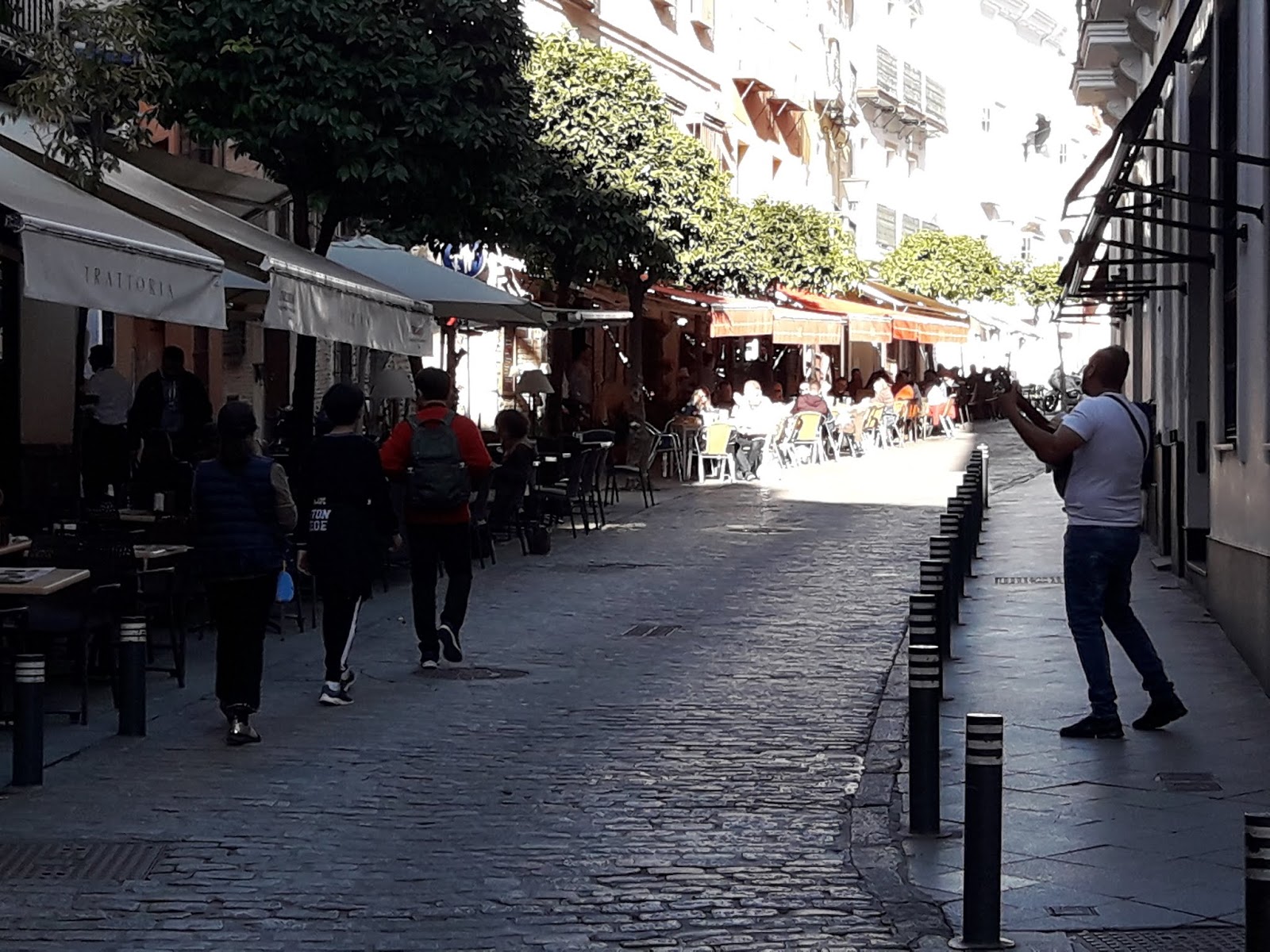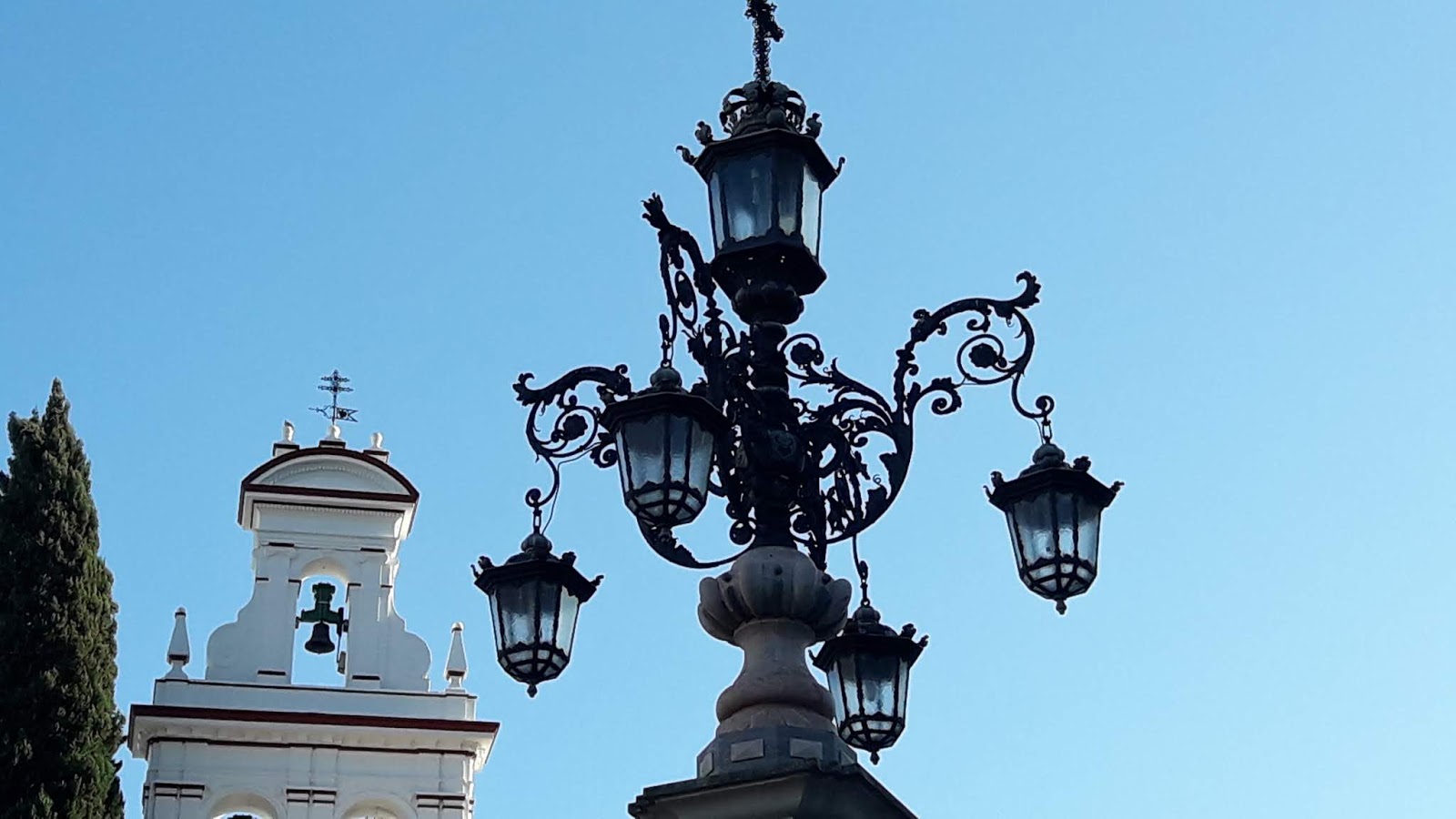I flew direct from Palma to Seville yesterday but in the early evening. We disembarked the plane via stairs onto the tarmac. Seville's airport is rather outdated but is in the midst of being renovated. I took a taxi to my Airbnb apartment in the center of old town. On the way there, I wasn't very impressed with what I was viewing outside. Lots of bland, blockish apartment buildings...their facades dotted with beat-up air conditioner compressor equipment. YUCK!!
We drove through a portal in the old city wall onto narrow cobblestone streets...a whole 'nuther world. There's very limited traffic in the old town because many streets are either pedestrian-only or simply aren't wide enough for vehicles. Busses are relegated to the only few streets wide enough for them to navigate. My taxi stopped and said he couldn't go any further because the street had been blocked off with a temporary barrier. So, I paid him $22 and schlepped the remaining 500 feet or so. I used Google maps to guide me, but the one frustrating thing about that tool is you can't tell which way you're facing in relation to the map! Do I walk left, right, straight ahead? You have to walk and watch the little dot move on the map to see which direction you're moving versus which way you NEED to go. After a few mistakes, I finally arrived at my Airbnb apartment.
This trip is a Home Exchange, but not in Seville. I chose to tack on a few days before the exchange so I could explore nearby Seville.
The apartment was in perfect location, very modern, and had a jacuzzi tub!!! The cost was only $50 a night plus $44 for Airbnb's service fee and cleaning. I had a $100 award from Airbnb for being a 'SuperHost' (in Ecuador) and applied that to my balance owing. The result was about $90 for a 3 night stay. Though the apartment was exceptionally nice, it lacked what I feel are obvious 'should haves' such as a microwave (there was one in the common room downstairs but who wants to go down 2 flights to zap some popcorn?), no toaster, and there was no way to make ice.
For my first full day in Seville, it was sunny and 65 in the first week of December! Seville has a population of about 700,000 and is the 4th largest city in Spain. It's the only city in Spain with an inland shipping port, approximately 50 miles upstream from the Atlantic.
I must say I was surprised at the amount of graffiti I saw in the old town. It seemed every structure was splattered with something and there didn't seem to be any effort to remove it.
I must say I was surprised at the amount of graffiti I saw in the old town. It seemed every structure was splattered with something and there didn't seem to be any effort to remove it.
A portion of the wall surrounding old town, dating back to the 12th century.
I took the HoHo (Hop On Hop Off) double decker bus tour. After it was all said and done, I could've done without it. It seemed more like a shuttle to get you to sites because many places we passed by you couldn't see much.
Streetlights in the center median of an arterial in the modern area.
Built in 1929 for the Ibero-American Exhibition, this building now houses the Consulate of Coumbia.
Built in 1893, this is known as the 'Queens Sewing Box'. Today, it serves as a tourist office and marks the entrance to Maria Luisa Park where Plaza Espana is located.
The Torre del Oro (tower of gold), built in the 13th century, was once a watchtower integrated with the old walls and controlled access to the port. It's the tower on the right and not gold.
The only 'skyscraper' in Seville opened in 2016 and stands 600 ft tall with 40 stories.
You'd never guess this is a government office building.
Notice the 'leaning' building in the background.
The HoHo bus squeezing through old town.
Here's some footage from the tour.
There's a lot of Arabic influence in the architecture of this area.
Strolling through the maze of narrow streets lined with boutique shops.
Giant squared ficus trees in front of the bank.
Wednesday, December 4, 2019
Today, I set out to find the 'mushroom thingy'. I needed to find Plaza Encarnacion to see it. But, Google maps led me to an area next to the Cathedral where I wandered back and forth and criss-crossed myself over and over but couldn't find it. I asked a person securing the entrance to the Cathedral...surely she would know. She pointed me to go around a building then a couple more turns, blah, blah. Well, I ended up right back where I started. I wasted a LOT of time trying to find this thing...a thing so out of this world and so large how could anyone not know where it is? Well, suffice to say, I accidentally ran into it later on and it was NOWHERE close to where Google maps had been directing me!!!
'Metropol Parasol' (or Las Setas) was launched to revitalise the Plaza de la Encarnación, for years used as a car park and seen as a dead spot between more popular tourist destinations. Constructed from crossed wooden beams, Las Setas was completed in 2011 and is said to be the largest timber-framed structure in the world.
For $2, you can take an elevator to the roof and walk a meandering pathway from one end to the other. Below ground is a grocery market and an archealogical museum.
This makes me think of a monstrous space ship landing in some neighborhood on Earth.
Here's a short video taken while wandering around on the roof!
An old church across the street.
What is it with snails being incorporated into the architecture in Spain?
I took a light-rail tram (the only one) to go see Plaza Espana. We passed it on the HoHo bus tour, but didn't get to see much of anything. It's located in Maria Luisa Park but the park is pedestrian only.
Plaza Espana
Built in 1928 for the Ibero-American Exposition of 1929.
I hoofed it out of the park and back to the light-rail station. I took it one stop and hopped off to see the Cathedral. But, it was due to close in 30 minutes, so I decided to head back to my apartment. Google maps 'informed' me it would be an 18 minute walk. RIGHHHHHTT!!!!! It took me 45 minutes and I about died from the pain in my knee. Back in the apartment, I poured myself a hearty vodka!!!
By the way, if you're interested in viewing any of my past entries about travelling around Europe and where I live in Mallorca, simply scroll down past my signature to the end. There, you'll see 'Blog History'. You can click on any Month/Year to see the titles I published at that time. Simply click on the title you're interested in and it will take you to that page.
Next up...
I visit the largest Gothic Cathedral in the World!
I visit the largest Gothic Cathedral in the World!
Dano















































I was wondering too about the snails and all the other gargoyles and people included in buildings' architecture. Have your wanderings and research explained how and why different animals and people are included in building design and construction?
ReplyDelete